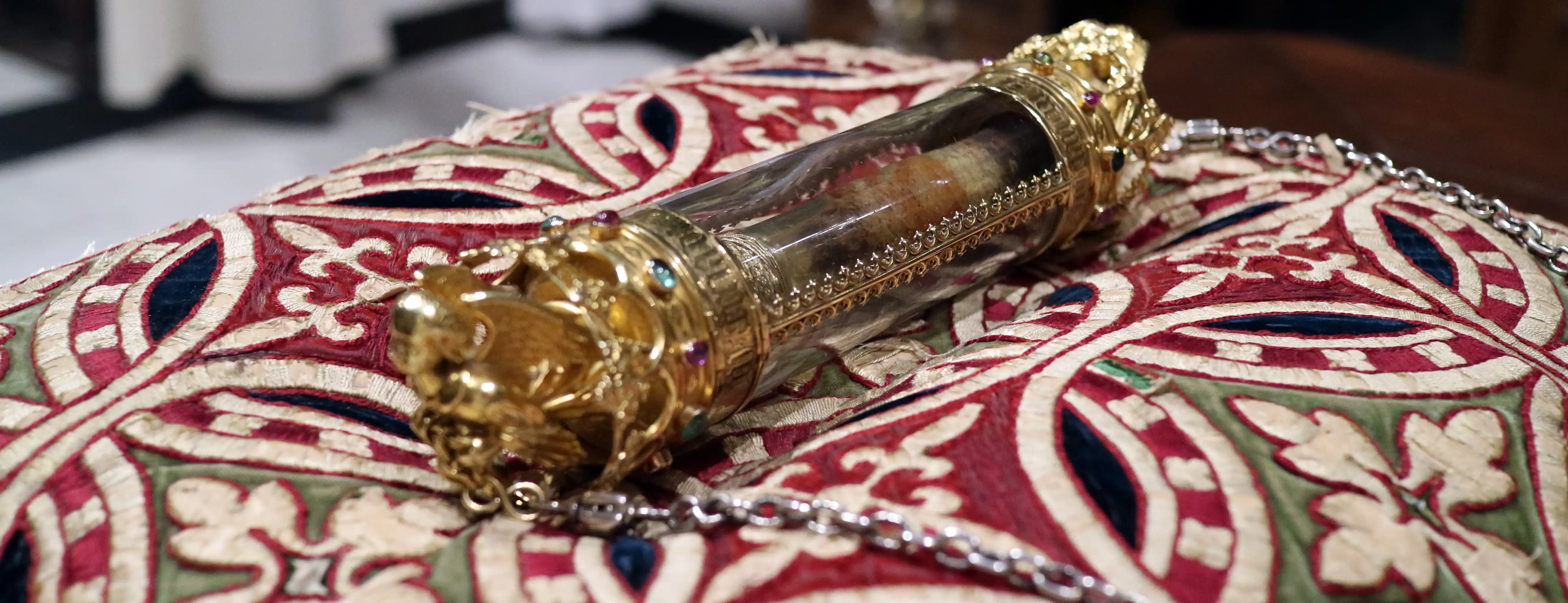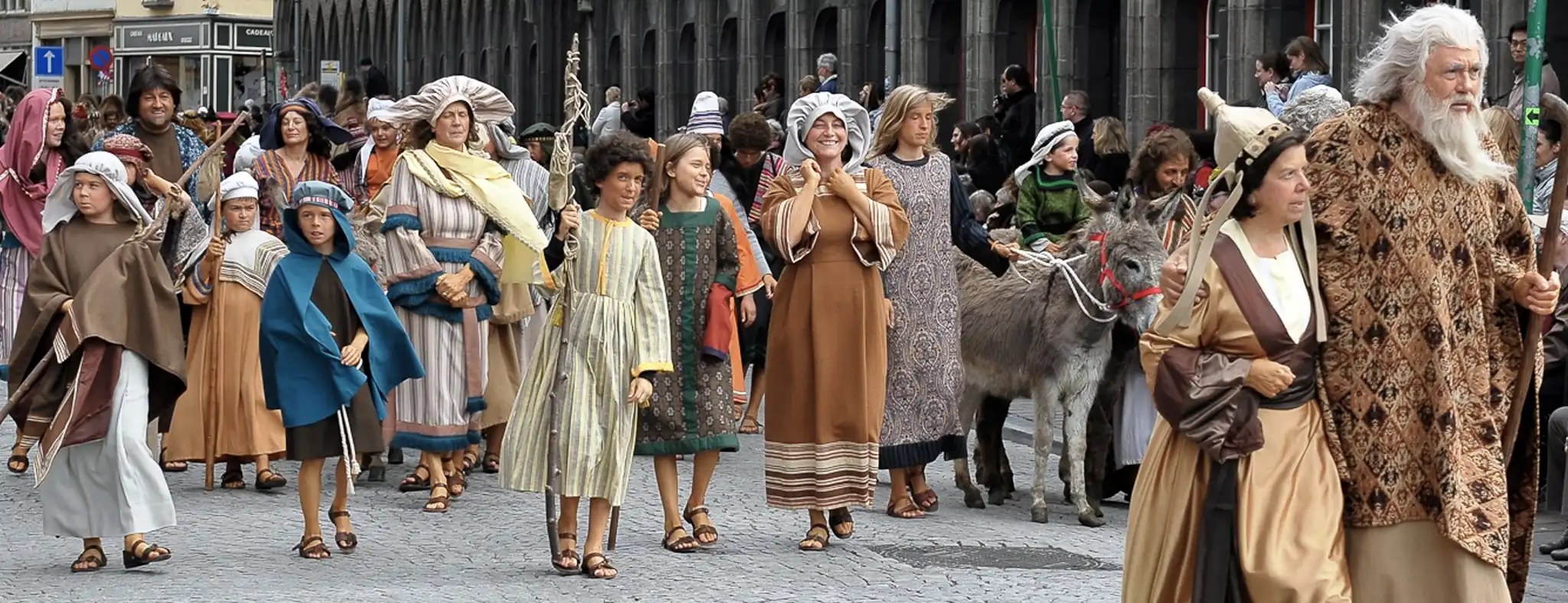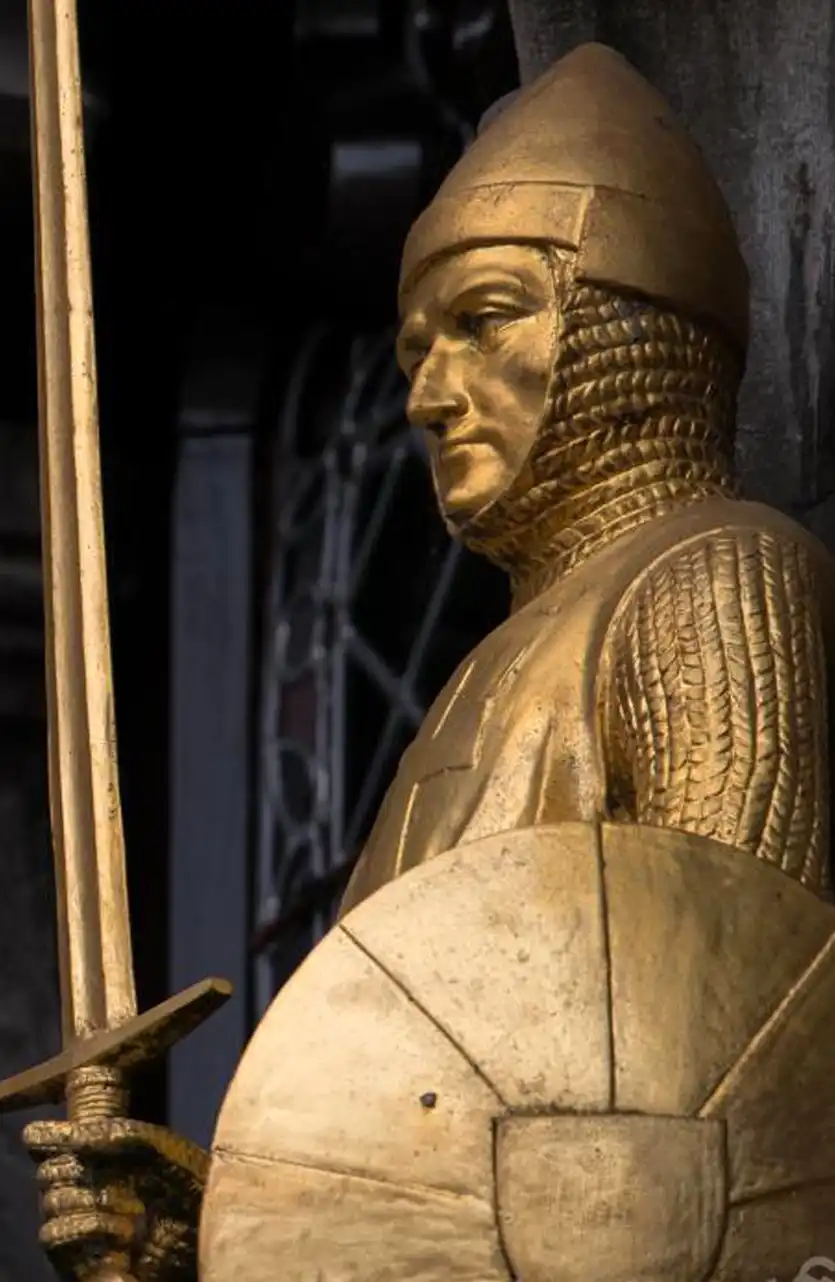
Daily veneration Holy Blood
Every day, the relic of the Holy Blood is presented to visitors for veneration in the upper basilica:
- every afternoon from 2:00 pm to 4:00 pm
- every Friday morning from 10:15 am to 11:00 am
Feast of the Holy Blood
Sunday 4 May 2025
- 10:00 am: Veneration of the Holy Blood
- 11:00: Eucharist
- 2:00 pm: Veneration of the Holy Blood (until 4:30 pm)
Week of Prayer of the Holy Blood
from SUNDAY 25 May 2025 to SUNDAY 1 June 2025
Procession of the Holy Blood
THURSDAY 29 May 2025
Every year there is the procession of the Holy Blood on the Thursday in the Week of Prayer of the Holy Blood, on Ascension Day. Then the shrine with the relic is carried by bishops and prelates through the streets of Bruges, in a solemn and colorful procession with 1700 participants. This unique procession is usually attended by approximately 35,000 spectators. For more information about the procession, see: www.bloedprocessiebrugge.beThe veneration of the Holy Blood through the ages
Significance of the Blood of Christ
Through the Holy Blood Relic, Christians commemorate that Jesus went to the extreme for them out of pure love, by giving His life on a torture cross.
On the cross his body was broken like bread and his Blood was shed like wine. Although Jesus was sinless, innocent as a lamb,
He was condemned and humiliated as a criminal. But Christians believe that He did not suffer for nothing, because thanks to the sacrificial blood
of the Lamb of God, all who believe in Him are washed and redeemed from all sins, or as the Apostle Peter wrote:
You have been paid and redeemed by the precious blood of Christ, the perfect Sacrificial Lamb (1 Peter 1:19).
How the Blood of Jesus Christ ended up in Bruges
According to the Gospel of Matthew (27: 60), Joseph of Arimathea was the owner of a garden in which was a new tomb. After the crucifixion of Jesus, he asked Pontius Pilate to be allowed to place the body of Jesus in that unused tomb. After Joseph of Arimathea took Jesus from the cross, he washed Jesus bloody body with cloths and then wrapped Jesus' body in a shroud. Naturally, he did not just throw away the cloths soaked in Jesus' blood, but they were kept in Jerusalem like the other passion relics.
The fact that Thierry of Alsace (Count of Flanders from 1128 to 1168) transferred the Relic of the Holy Blood from Jerusalem to Bruges in 1150 is nowadays strongly doubted by most historians. According to them, this is a persistent legend, invented by the 14th century monk Johannes Iperius in his chronicle, the Chronicon Sithiense S. Bertini. After all, the monk was repeatedly exposed by later historians as a dreamer who sometimes violated history with his stories.
The oldest reliable sources about the relic date back to the 13th century. A number of those sources show how proud the residents of Bruges and the Bruges city council were of their relic and how much they are attached to it. But during the 12th century, as far as historians could ascertain, not a single resident of Bruges wrote a word about the relic's presence in Bruges. In none of the 12th century sources a connection is made between the relic on the one hand and Thierry of Alsace or the St. Basil's Chapel (the later Holy Blood Basilica) on the other hand, simply because there was no Holy Blood to be found in Bruges at the time.
Today, most historians tend to link the Relic of the Holy Blood to the fall and looting of Constantinople in 1204. It was shown that during that looting many valuable relics from Contantinople (Istanbul) were taken by crusaders to Western Europe. In addition, research also shows that the tube of the Holy Blood Relic was made around 1200 from rock crystal ... from Constantinople.
How the blood of Jesus Christ ended up in Constantinople, we can only guess for the moment. Saint Helena of Constantinople (248-329), the mother of Emperor Constantine the Great, is said to have taken many passion relics (including the relics of the Holy Cross) from Jerusalem to Constantinople. Could the Blood of Jesus Christ have been among those relics too?
History of the Procession of the Holy Blood and the Week of Prayer of the Holy Blood
1291: Oldest mention of the procession in a document of the guild of the painmen (redeemers). This shows that the Bruges' guilds and crafts were obliged to participate in the procession. The procession probably originated from this custom.
1303: There is talk of a procession of the Holy Blood around the city walls. Because the relic was owned by the city, the procession became a civil official event in which horsemen, crafts and guilds, gunmen, the city magistrate and of course the clergy marched with the relic in all pomp and circumstance. From 1303 to 1969, the procession took place every year on the first Monday after May 1, also the day on which the Holy Cross Finding was celebrated, an important ecclesiastical celebration in our region.
1310: Pope Clement V, the first Pope to rule in exile from Avignon, issued a solemn "Papal bull", which he sealed with his lead seal on June 1, 1310. With this document, written on solid parchment, which is still preserved in the city archives of Bruges, Pope Clement V encouraged the faithful to make a pilgrimage to Bruges, to venerate the relic with the Blood of Jesus Christ. Subsequently, the Bruges city government decided to organize an annual "Fortnight of the Holy Blood" in the month of May, to coincide with the annual fair (the Mayfair from April 23 to May 22). As a result, this led to an increase in the number of people and in devotion of the Holy Blood grew.
15th - 16th century: In addition to the biblical scenes (mystery plays), the procession now also included profane scenes with giants (the horse Bayard with the four children of Aymor) as well as the rhetoric chambers.
1578: Because of the religious troubles, it was considered safer not to carry the relic outside the city gates and the procession took place "intra muros" for the first time.
1578 - 1584: Bruges had a Calvinist city council. The procession was suspended and the relic was taken to safety. During the Counter-Reformation (17th century) and also in the 18th century, the procession regained its religious character. Floats with all kinds of symbols and images gave the procession a triumphant character.
1796-1819: During French rule, the Procession of the Holy Blood was interrupted again and the relic was safely stored.
19th century: The procession was composed by the seven parishes of the city with its numerous brotherhoods, congregations and schools.
20th century: The procession went through several changes, some of them major, in terms of content and presentation.
2000: From now on, the procession has been conceived in a style that harks back to the Golden Age (15th century), when Bruges, as the residence city of the Burgundian dukes, was a busy trading market with one of the most important ports north of the Alps.
2001: The veneration of the Holy Blood was from now on organized every day, while the veneration previously only took place on Fridays, on the Feast of the Holy Blood and daily during the Fortnight of the Holy Blood.
2008: The "Fortnight of the Holy Blood "was shortened to" Week of Prayer of the Holy Blood ".
2020-2021: Due to the corona pandemic, the Procession of the Holy Blood was suspended for two consecutive years.

Significance of the procession of the Holy Blood
The procession of the Holy Blood is recognized by UNESCO as Intangible Cultural World Heritage
The procession of the Holy Blood tries to answer the questions everyone has on the meaning of life and on the existence of the world. Everyone longs to be deeply happy.
That happiness has different names, according to the cultural background, called by some "Nirvana", by others "Heaven", or, in the biblical tradition : "the Kingdom of God", "Sion" or "the new Jerusalem".
Historical section
Preceded by heralds, flags and a band, Count Thierry and his followers come to Bruges in order to hand over the relic as a sign of the new Jerusalem.
They are acclaimed by the people of Bruges, even by the wealthy.
The Old Testament
The old myths tell of existential
matters concerning the life of man.
The paradise, the banishment of Adam and Eve, the fratricide:
The creation was entrusted to man by God. By serving the Creator he preserves and protects creation. He gives names to all creatures and, in doing so, he becomes fellow-creator with God. But man is at the same time good and bad. The greatest sin is the pride from which envy and quarrelling originate. Because evil is rooted in man, he passes his life seeking for happiness, peace and the meaning of his existence. Man is searching for his lost paradise.
Erring man:
God invites Abraham to leave his familiar surroundings and go to a strange but better land to start his life anew. Abraham allows himself to be led by God and thus becomes the prototype of the faithful man who trusts in God: the Bible calls this mutual relationship the Covenant of God with his people.
The rejected man becomes the saviour.
Joseph, the favourite of his father Jacob, is sold by his brothers : as long as humanity has existed, people have been chasing their "brother" and have not hesitated to kill others. Joseph, who became a councillor to the pharaoh became his brothers' savior when they were driven to Egypt by hunger. In this way, Joseph is the prefiguration of Jesus Christ, who, as an outcast, brings new life to humanity.
The prophets remind us of God's commission.
Troughout history, prophets appear who bring to our memory God's mission and the most fundamental rules of our life: respect of life, justice, love for and trust in God.
The New Testament or the life of Jesus Christ
The dawn of a new time.
Christ is born in a carpenter's family, in an insignificant place. It is the simple people, the shepherds, who first receive the message of joy. Therefore, those who seek the meaning of life must be attentive to the small and open to the unexpected. The three kings come to Jesus from different corners of the world.
The three kings, three wise men, come to Jesus from different parts of the earth, bringing with them the wisdom of Western, Eastern and African culture in order to attest that Christ is the answer to the question of the meaning of life. Later on, the Child Jesus is talking to the teachers with deep intuition and wisdom and He blesses the children because they are holy and receptive for God.
Jesus Christ gives the answer to the meaning of life.
The same Jesus who is now welcomed to Jerusalem in jubilation, will a few days later be put to death. This shows that man is two-faced. Before his death, during the last meal with his disciples, Jesus delivered them his message of love which in turn they should deliver to the world. Jesus, however, will be betrayed and brought before Pilate. He is sentenced to death in order to appease the anger of the people.
Scourged and crowned with thorns, Jesus climbs up the Golgotha carrying his cross.
He is the symbol after being of suffering and at the same time of indestructible life and loyalty to love. The resurrection of Jesus, the central point of the Christian faith, means He is close to all who come to Him and, in doing so, live in joy and in peace.

